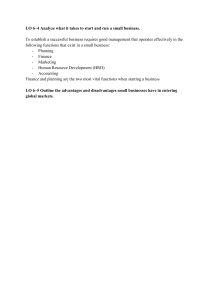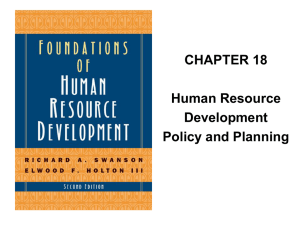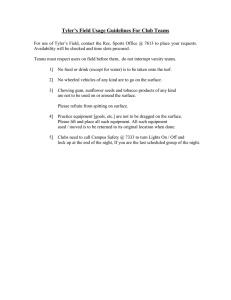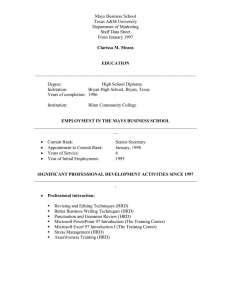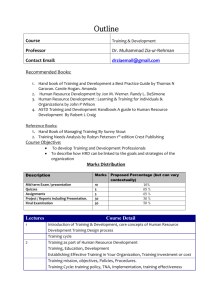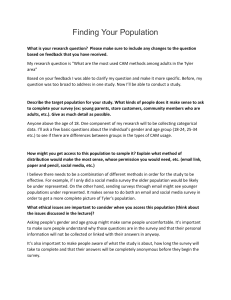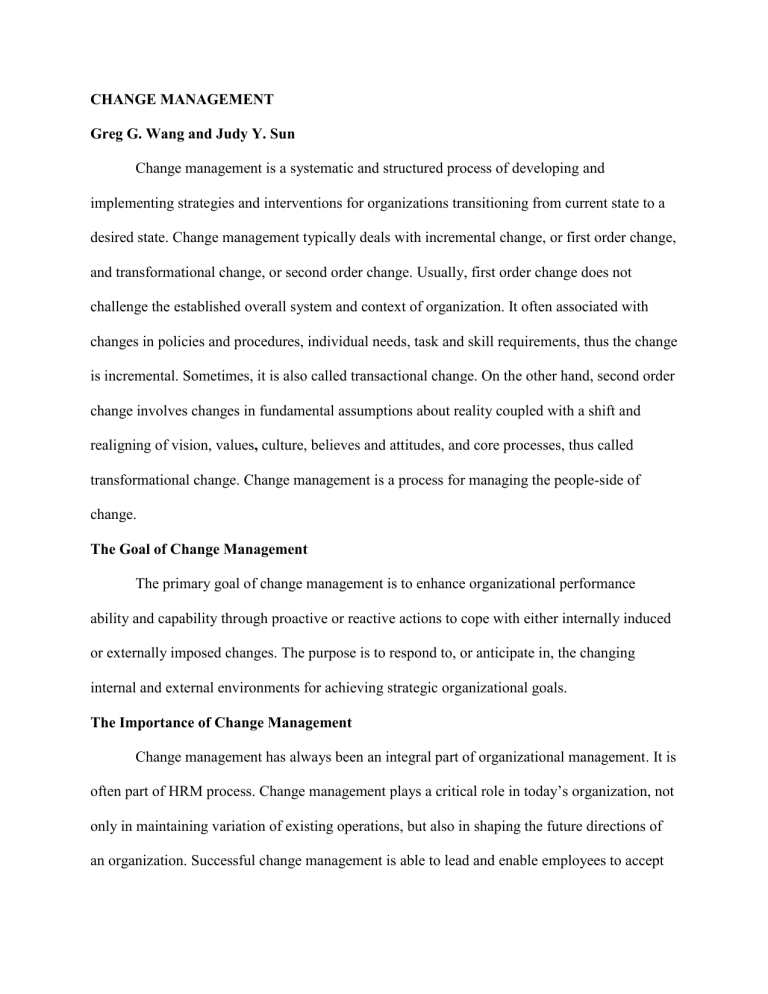
CHANGE MANAGEMENT Greg G. Wang and Judy Y. Sun Change management is a systematic and structured process of developing and implementing strategies and interventions for organizations transitioning from current state to a desired state. Change management typically deals with incremental change, or first order change, and transformational change, or second order change. Usually, first order change does not challenge the established overall system and context of organization. It often associated with changes in policies and procedures, individual needs, task and skill requirements, thus the change is incremental. Sometimes, it is also called transactional change. On the other hand, second order change involves changes in fundamental assumptions about reality coupled with a shift and realigning of vision, values, culture, believes and attitudes, and core processes, thus called transformational change. Change management is a process for managing the people-side of change. The Goal of Change Management The primary goal of change management is to enhance organizational performance ability and capability through proactive or reactive actions to cope with either internally induced or externally imposed changes. The purpose is to respond to, or anticipate in, the changing internal and external environments for achieving strategic organizational goals. The Importance of Change Management Change management has always been an integral part of organizational management. It is often part of HRM process. Change management plays a critical role in today’s organization, not only in maintaining variation of existing operations, but also in shaping the future directions of an organization. Successful change management is able to lead and enable employees to accept new vision, new behavior, and new culture. Regardless of dealing with proactive or forced changes, successful change management can determine an organization’s future status on survival, development, and strategic direction. The Process of Change Management A number of change management models or processes are available. While differing in specifics, most models contain the following three phases. (1) Preparing for the change, including analyzing, planning, and strategy development, The purpose of this phase is to analyze the scope of the change by addressing the following questions: How big is this change? How many people are affected? Is it an incremental or radical change? What is the value system and background of the impacted groups? How much change is already going on? What is the anticipated resistance? What is the expected outcome of the change? (2) Managing change implementation Communicating the right message at the right time is critical in change management. It involves in awareness building of the change and the risk of maintaining status quo. Communication plan need to be specifically developed for employees at all levels based on their roles in implementing the change. Obtaining front-line managers’ buy-in. Because direct supervisor has more influence on employees’ motivation to change than others, it is vital to gain the support of supervisors for building change leadership. Individual or group coaching is often necessary for facilitating the buy-ins. Training and development can be part of the change implementation to build knowledge, skills, behavior, and attitude required for the change. Managing resistance. Resistance from employees and managers is expected in any change efforts. Persistent resistance, however, can threaten the change effort. It is vital to identify, understand, and manage resistance throughout the organization. (3) Consolidating and institutionalizing the change, including change review, feedback analysis, corrective action, and stabilize the implemented change. This phase involves in the following activities. Review and evaluate the successes and failures, and identify needed modifications for improving and implementing desired change outcome. Establish processes for ongoing and continuous improvement. Establish necessary policies and procedures to institutionalize the change. Involving employees is an integral part of change management throughout the process. Feedback from employees is a key element of the change management process. Analysis and corrective action based on this feedback provides a robust cycle for implementing and improve change outcome. Typical Criticisms of Change Management Criticism on change management is often around the following issues. A first issue is that change management is unnecessary and irrelevant to the core business. A second criticism is that change management does not require a process as people will change when they are forced to. A third issue is that change has become a constant in people’s daily life; therefore, no special effort is needed to implement change. A fourth issue is that change only involves management teams. Employees will follow if management decides to change. Web Links: http://en.wikipedia.org/wiki/Change_management_(people) http://www.odnetwork.org/ http://www.businessballs.com/changemanagement.htm Selected References For more information, see Bartunek, J. M., & Moch, M. K. (1987). First-order, second-order, and third-order change and organization development interventions: A cognitive approach. Journal of Applied Behavioral Science, 23, 483–500. Beer, M. & Nohria, N. (2000). (Ed.), Breaking the code of Change. Boston, Massachusetts: Harvard Business School Press. Judson, A. (1991). Changing behavior in organizations: Minimizing resistance to change. Cambridge, MA: Basil Blackwell. Lewin, K. (1947). Frontiers in group dynamics. Haman Relations, 1, 5-41. Contributor Information Greg G. Wang, PhD, is a professor in the Department of Human Resource Development and Technology at The University of Texas at Tyler. He also serves as Editor of Journal of Chinese Human Resource Management. He has worked for and consulted with multinational companies such as GE, IBM, and Motorola. His research interests include HRD policy, career development, comparative HRD, international HRD, and economics of HRD. Judy Y. Sun is a senior lecturer in the Department of Human Resource Development and Technology, College of Business and Technology, University of Texas at Tyler. She has worked for and consulted with multinational corporations such as Motorola and KPMG. She also served as the Director of Career Development at a major business school in China. Her research interests include career development, executive development, and organizational learning. Please enter here your: Name Greg G. Wang Title Professor__________________________________________ Organizational Affiliation __University of Texas at Tyler______________________ Your Email address ____wanggreg@aol.com ________________________________ Your Phone Number 903____(Area)_____565-5910_____________(Number)______ Fax 903______(Area)___565-5650____________(Number)______ Mailing Address 1600 Tall Timber Dr., Tyler, TX 75703______________ ____________________________________________________
